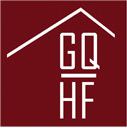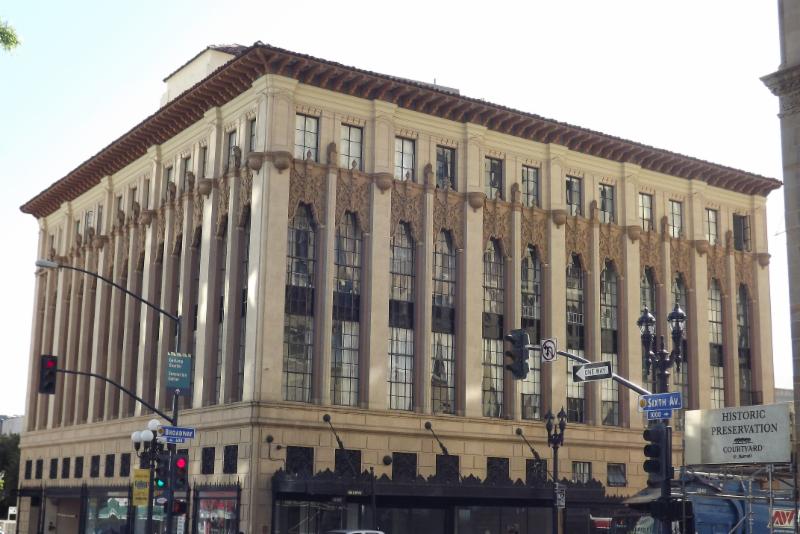Landmarks
The Tale of the Fox and the Lion
Samuel I. Fox Building, 1929
Architect: William Templeton Johnson
Architectural Style: Mission Revival & Mediterranean
Location: Southwest Corner, 6th & Broadway
America has always been the land of immigrants and opportunity. This was especially true during the 19th century when Horace Greeley’s philosophy that the road to success was paved with hard work and perseverance was the inspiration for many seeking a better and more prosperous way of life. Greeley was the founder of the New-York Tribune and felt that the unemployed of the cities should go to the newly developing West where their hard work and ingenuity would surely be rewarded. None was more inspired than Samuel Fuchs, a seventeen-year-old Hungarian, who arrived in New York City in 1879 with less than $5.00 to his name and only two English words in his vocabulary – “yes” and “no.” Sam was the son of a formally-wealthy merchant and land owner who had lost his money in the Franco-Prussian War. His mother urged him to immigrate. He fooled the border guards by convincing them that a gold-lettered school certificate which he showed them was really a passport!
Upon his arrival, Sam changed his last name to Fox and enrolled in night school to learn English. During the day, he peddled pencils. After seven years of frugal living and saving, he heeded Greeley’s advice, and headed West. After visiting several California cities, and against the advice of his sister, Samuel selected San Diego as his new home. His sister said he should choose a place “that was on the map.” Samuel said he’d put San Diego on the map!
Fox first became newsworthy in 1891 when he charged Isaac Levi, another immigrant, of battery. It seems that the two disagreed over a shared gas bill with ensuing name-calling and fisticuffs. A court appearance resulted in Fox proving battery but Strauss proving provocation, and the case being thrown out of court. However, Samuel Fox’s name was on the map!
In 1893, Fox married Pauline Kuhn, the sister of Isaac Kuhn, the founder of the Lion Clothing Company, which had been established in 1886. Fox managed the store, located at 858 Fifth Avenue, and when Kuhn passed in 1898, he purchased the property. His clever merchandising and business acumen made the nearly defunct company very successful. He placed two large paper mache lions at the entrance as entertainment for children, while their parents shopped. Additionally, he allowed them to buy ready-made clothing on credit. Thus, he filled the clothing needs of many San Diego families and was able to expand Lion Clothing to a new and much larger more prestigious site.

He chose the current location, Broadway and Sixth, which shared the intersection with two imposing structures – the San Diego Trust and Savings Bank and the John D. Spreckel’s Building. As the architect, he selected William Templeton Johnson, designer of the San Diego Trust and Savings Bank and also the Museum of Natural History. Although the structure was limited to four stories, Johnson incorporated several devices to further the illusion of height. A combination of both Mission Revival and Mediterranean architecture, the exterior featured cast iron decorative grills, sculptured terra cotta spandrels between the third and fourth floor, and heraldic lions (of course!) in full relief. Elaborate Victorian patterns decorated the soffiting between sculpted corbels. Additionally, an overhanging tile roof capped the imposing structure. The interior featured 16-foot ceilings, walnut window frames and antique oak paneling. The first two floors were devoted to menswear; the third floor housed the business offices and boys clothing, and the fourth floor featured fine women’s apparel. The total cost for this elaborate but refined structure was $500,000, and fortunately, construction was completed before the stock market crash in 1929. It has been called one of the most beautiful buildings in the Gaslamp.

Samuel Fox died of a heart attack in 1939 two years after the death of his wife. The business was taken over by his son, John Fox, who managed the business until his death in 1953. Ultimately the Lion Clothing Company was purchased by Cluett Peabody Company of New York, and in the 1970s by Marci’s Women’s Stores. It now houses 23 loft/condo units on the upper floors. The building has maintained its original details, but added a rooftop patio and barbecue area. BIGA restaurant occupies the first level.
Sandee Wilhoit is the historian for the Gaslamp Quarter Historical Foundation. She can be reached at [email protected].

